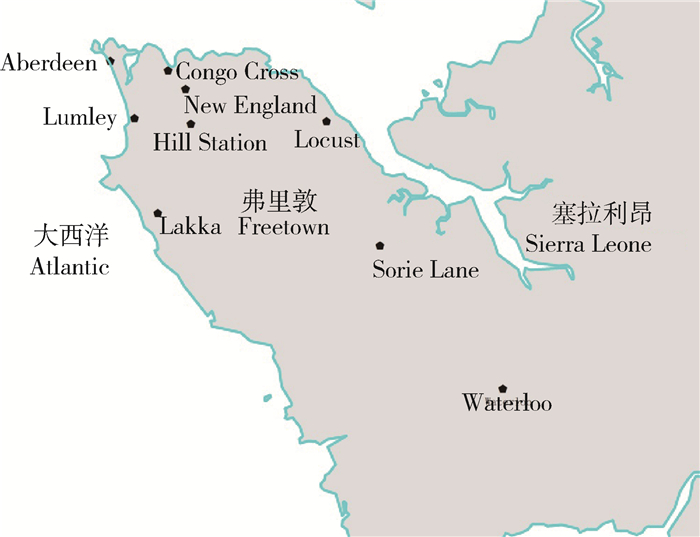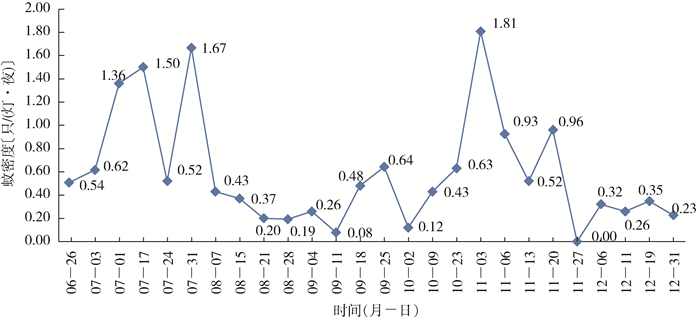An analysis of mosquito vector surveillance results in Freetown, Sierra Leone, 2019
塞拉利昂位于非洲西海岸, 是典型的热带气候, 温度范围为21~32 ℃, 平均温度为25 ℃;一年中主要有2个季节, 即雨季(5-10月)和旱季(11-4月), 7-8月有大量降雨, 年平均降雨量为320 cm, 相对湿度范围为60%~90%。塞拉利昂地形多样, 从海岸沼泽、内陆沼泽和热带雨林, 再到西非最高的山脉之一(Bintumani Mountain)。次生棕榈树是主要的植被, 并且散布着许多用于水稻种植的沼泽[1]。塞拉利昂适宜的温度、湿度和生态环境为蚊虫提供了理想的孳生场所, 蚊媒传播的有疟疾、淋巴丝虫病、黄热病、登革热、流行性乙型脑炎和寨卡病毒病等多种疾病[2]。全世界发现的3 000余种蚊虫中约有300种可以传播蚊媒病毒[3-4], 蚊媒疾病的发病率和死亡率非常高。2018年全球大约有2.28亿例疟疾病例, 非洲仍然是疟疾的高发地区, 共有2.13亿例(93.40%)疟疾病例[5]。塞拉利昂是非洲国家中疟疾发病率最高的国家之一[5], 疟疾已在塞拉利昂成为稳定且常年传播的蚊媒传染病, 约占50%的门诊病例, 且为5岁以下儿童发病和死亡的主要原因[6]。研究报道, 对塞拉利昂博城2012-2013年的发热病例进行血清学检测, 55%的病例至少感染了疟疾、登革热和基孔肯雅热中的一种, 塞拉利昂承受着非常重的蚊媒传播疾病负担[7-11]。尽管疟疾和其他蚊媒传播疾病负担如此沉重, 塞拉利昂的控制方法仍主要集中在病例管理, 而控制病媒、切断传播途径方面的努力非常有限。
病媒控制是预防、控制和消除蚊传疾病战略的重要组成部分。目前, 塞拉利昂预防和控制蚊媒传播疾病的主要措施为药浸蚊帐(insecticide treated nets, ITN)和室内滞留喷洒(indoor residual spraying, IRS), 这些措施的有效实施都必须建立在病媒监测能力的基础之上。但是, 塞拉利昂最近的昆虫学研究是在1990-1994年内战之前开展的[12], 缺乏近期蚊媒监测数据。因此, 迫切需要在塞拉利昂建立蚊媒监测能力, 以了解当地蚊虫密度、地域分布、种群特征和季节消长等情况, 为其制定蚊媒传播疾病的预防和控制措施提供科学依据。本研究在塞拉利昂首都弗里敦西部城区及农村设立了9个蚊媒监测点, 自2019年6-12月共监测蚊虫密度26次, 并对监测数据进行了统计分析。
1 材料与方法
1.1 数据来源 塞拉利昂首都弗里敦市2019年6-12月的蚊媒监测数据来源于中国疾病预防控制中心援助塞拉利昂第5批专家组。塞拉利昂首都弗里敦市2019年4-12月降雨情况来自于中国气象局。
1.2 监测工具及监测点设置 在塞拉利昂弗里敦市西部城区及农村共选取9个区域设置成蚊监测点, 分别选择居民区、一般单位、医院和牲畜棚各不少于1处。采用诱蚊灯(MYFS-HJY-1, 东莞厚积电子科技有限公司)法对成蚊进行监测。
1.3 监测方法及频率 9个成蚊监测点, 每处布放2~4台诱蚊灯。布灯点选择室外避风避雨避光处, 诱蚊灯距离地面约1.5 m。于日落前1 h开始布放诱蚊灯, 翌日日出后1 h收集诱蚊灯的集蚊网, 带回实验室进行蚊类形态学鉴定。每周监测1次。
1.4 密度指标计算 蚊虫密度指数计算公式:
1.5 统计学分析 采用ArcGIS 10.7软件绘制塞拉利昂弗里敦市蚊媒监测点地图。应用Excel 2007软件录入9个监测点的蚊媒监测数据, 计算监测成蚊总数、蚊种构成比、蚊虫密度季节变化消长等数据。
2 结果
2.1 蚊种构成及密度 9个监测点分别设在Hill Station、Sorie Lane、Aberdeen、Congo Cross、New England、Waterloo、Lakka、Lumley和Locust社区内, 其中Lakka、Waterloo和Sorie Lane 3个监测点位于弗里敦市西部农村, 其他6个监测点位于弗里敦市西部城区, 监测点分布见图 1。
2019年6月26日至12月31日期间平均每周监测1晚, 共对9个监测点进行了26次蚊媒密度监测工作, 共收集蚊虫3 012只, 弗里敦地区平均蚊密度为4.35只/(灯·夜)。对捕获蚊虫进行属分类鉴定, 其中库蚊为2 556只, 占捕蚊总数的84.86%, 为优势蚊属;疟疾传播媒介按蚊占13.61%, 伊蚊占1.43%;各监测点蚊虫种类构成见表 1。
表 1 塞拉利昂弗里敦市不同监测点蚊种数量及构成
Table 1 Number and composition of mosquitoes at different surveillance sites in Freetown, Sierra Leone
西部城区监测点结果显示, 库蚊在各监测点的构成比为85.72%~98.33%, 按蚊构成比为0.72%~11.90%;西部农村监测点结果显示, 库蚊在各监测点的构成比为53.85%~97.15%, 按蚊构成比为1.14%~44.53%, 见表 1。
2.2 不同监测点蚊密度 平均蚊密度西部农村为5.01只/(灯·夜), 西部城区为3.87只/(灯·夜)。各个监测点进行比较, Lakka蚊密度最高, 为10.29只/(灯·夜);New England蚊密度最低, 为1.18只/(灯·夜);各监测点蚊密度见图 2。
2.3 蚊密度季节消长 图 3、4显示, 自5月开始弗里敦地区出现小雨天气, 进入6月雨水进一步增多, 此时正是塞拉利昂旱、雨季交替时期, 6月底7月初的蚊虫密度处于较高水平, 最高达到6.42只/(灯·夜)。随着雨季的到来, 7和8月降雨量加大, 中雨和大雨天气明显增多, 蚊密度逐渐降低, 8月下旬到达谷底, 最低为1.60只/(灯·夜)。9月之后降雨量逐渐减少, 蚊密度回升, 10月底时蚊密度达到高峰, 为7.23只/(灯·夜)。11月降雨量进一步减少, 12月已基本无雨, 蚊密度有所回落, 最低为2.52只/(灯·夜)。
2.4 按蚊密度季节消长及主要来源 图 5显示, 按蚊密度季节消长趋势与总蚊密度趋势一致, 7月按蚊密度升高, 最高为1.67只/(灯·夜);8和9月按蚊密度较低, 最低为0.08只/(灯·夜);10月按蚊密度开始回升, 最高达1.81只/(灯·夜);12月随着旱季的到来, 按蚊密度开始降低。
采集的410只按蚊, 其中362只来源于西部农村, 平均按蚊密度为1.28只/(灯·夜);48只采集于西部城区, 平均按蚊密度为0.12只/(灯·夜)。西部农村监测点Lakka占比最高为80.48%, 西部城区Hill Station监测点占比最低为0.24%(图 6)。
2.5 不同生境蚊密度 监测结果显示, 牲畜棚中蚊密度最高, 为10.40只/(灯·夜), 其次是居民区为4.45只/(灯·夜), 一般单位及医院的蚊密度较低, 分别为2.80和1.21只/(灯·夜)。进一步比较不同牲畜棚诱捕的蚊密度, Lakka、Lumley、Sorie Lane和Waterloo牲畜棚分别为17.45、11.68、6.27和5.44只/(灯·夜)。
3 讨论 监测结果显示, 弗里敦地区库蚊占捕蚊总数的比例最高, 是优势蚊属, 其次是按蚊, 伊蚊数量最少, 但这并不能完全反映当地蚊虫的构成比, 因为伊蚊主要在白天活动, 而本研究中采用的诱蚊灯用于晚上监测, 所以伊蚊的数据不能代表当地的真实情况, 在后续的监测中可以同时考虑针对伊蚊的监测方法, 比如双层叠帐法和布雷图指数法等[13]。通过形态学鉴定, 弗里敦地区按蚊主要为冈比亚按蚊(Anopheles gambiae)和致死按蚊(An. funestus), 其中冈比亚按蚊为优势种, 该结果与1901年研究结果所述一致[1];伊蚊的优势种为埃及伊蚊(Aedes aegypti), 其他蚊种以及亚种需利用分子鉴定技术进行分类。西部农村及城区的监测结果显示, 西部农村诱捕到的平均总蚊密度和按蚊密度均大于西部城区, 而且按蚊在西部农村监测点的构成比高于西部城区, 尤其是Lakka监测点, 可能是因为Lakka周围有稻田, 稻田是按蚊喜爱的主要孳生地之一[2]。这些结果说明在西部农村, 特别是在按蚊喜欢的稻田和沼泽地等附近, 被蚊虫叮咬、感染疟疾的风险要高于西部城区。
塞拉利昂的雨季是每年的5-10月, 2019年从5月开始降雨量增加, 降雨量的增多是蚊密度增加的主要原因, 因此6月底7月初旱、雨季交替时期, 蚊密度处于较高水平。7和8月有大量降雨, 但是蚊密度却从7月底开始逐渐降低, 8月下旬达到谷底。蚊卵羽化出成蚊需要经历幼虫期和蛹期, 这个生长发育过程在稳定的水体内、适宜的温度条件下至少需要7 d [2], 而塞拉利昂的7、8月几乎每天都有大量的降雨, 过多的雨水不断冲刷着地面上的水体, 致使蚊卵还未完成生长发育过程, 就已经被新的雨水冲走, 故8月下旬的蚊密度反而很低。进入9月, 降雨量减少, 容易形成较稳定的水体供蚊虫孳生, 蚊密度开始反弹, 10月达到高峰。11月之后, 随着雨季的结束旱季的来临, 降雨量大量减少, 蚊虫的孳生地也会减少, 所以蚊密度有所回落。按蚊的密度季节消长趋势与总蚊密度趋势一致。上述结果也很好地解释了塞拉利昂疟疾传播的2个高峰, 第1个高峰在5月的雨季开始, 第2个高峰在10月底至11月期间[14]。上述结果提示, 塞拉利昂6-7月旱、雨季交替时期和10-11月雨、旱季交替时期为防控蚊媒及其传染病(如疟疾)的关键时期。
对不同生境的蚊密度进行比较, 发现蚊密度与各监测点环境卫生状况密切相关, 环境卫生状况较好的医院和一般单位, 蚊虫孳生地较少, 蚊密度较低, 其次是居民区, 牲畜棚的卫生环境最差, 蚊密度最高。进一步比较不同监测点牲畜棚之间的蚊密度, 发现Lakka的蚊密度要远高于其他牲畜棚监测点, 因为Lakka周围有稻田, 孳生地的存在与否在一定程度上决定了蚊密度的高低。塞拉利昂的《2016-2020年国家疟疾战略计划》包括3种主要媒介控制干预措施:睡觉时使用药浸蚊帐、室内残留喷洒和孳生地管理。该战略指出, 将根据塞拉利昂当前的风险情况分层次部署这些干预措施。尽管孳生地管理是塞拉利昂疟疾控制战略重要的一部分, 但目前并未实施[14]。因此, 建议塞拉利昂在今后预防和控制蚊媒传染病的措施中, 进一步加强蚊媒孳生地管理。
 2020, Vol. 31
2020, Vol. 31













